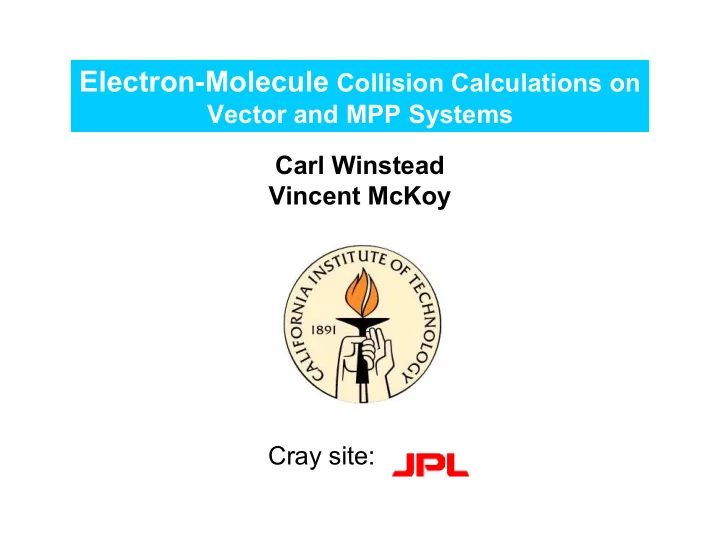

Electron-Molecule Collision Calculations on Vector and MPP Systems Carl Winstead Vincent McKoy Cray site:
Work supported by
Electron-molecule collisions in plasmas • Elastic collisions affect electron transport and energy deposition • Inelastic collisions deposit large amounts of energy and create reactive fragments – ionization – dissociation
Electron-impact dissociation in plasmas
Electron-molecule collision data • Measurements are often unavailable – few groups engaged in the work – some gases hazardous or difficult to work with – measurements of inelastic cross sections especially challenging • Calculations are an alternative
Requirements • At the low impact energies of interest, an accurate quantum-mechanical treatment of the collision is necessary • A method must address – Molecular targets of arbitrary symmetry – Exchange interactions (indistinguishable particles) – Target polarization (distortion of molecular electron density) – Electronic excitation (multichannel problem)
Variational approach • Variational methods are widely used to obtain useful approximate solutions to many-body problems • Variational methods for collisions generally lead to matrix equations of the form Ax = b where A and b are known matrices
The Schwinger multichannel (SMC) method • We use a multichannel extension of the variational principle introduced by J. Schwinger in 1947 • Applicable to molecules of arbitrary shape • Treats inelastic as well as elastic collisions
Electron collision calculations • Accurate calculations scale rapidly with molecular size • Calculations on larger fluorocarbons such as c -C 4 F 8 , c -C 5 F 8 require very high operation counts (10 15 -10 16 )
Integrals, integrals, and more integrals • Construction of A and b requires the evaluation and transformation of large numbers of two-electron repulsion integrals of the type Ú d 3 r 1 Ú d 3 r 2 a ( r 1 ) b ( r 1 ) Ω r 1 - r 2 Ω -1 g ( r 2 )exp(i k · r 2 ) where a , b , and g are Cartesian Gaussian functions of the form f(x, y, z) exp (- a | r - R | 2 ). • Scaling is 3 N k for evaluating integrals – N g 4 N k for transforming integrals – N g
How many? • 10 10 -10 13 integrals (10 12 -10 15 floating-point operations) are typical for 5-15 atom systems • Transformation of these integrals requires of the order of 10 12 -10 16 floating-point operations • Single-processor speeds ~ 10 9 floating-point operations/sec • 10 16 operations @ 10 9 operations/sec ~ 100 processor-days
Parallel computers are necessary • Complete calculations for polyatomic gases used in plasma processing (C 2 F 6 , c -C 4 F 8 ) are impractical on single-processor computers • Multiprocessor (parallel) computers provide the aggregate computational power (raw speed, memory, and I/O bandwidth) to make such calculations feasible • Single-processor computation on PVPs and workstations continues to play a role
Role of PVP Systems • Not all code worth parallelizing – Some steps more disk-intensive than CPU- intensive – Others logically intricate but with low operation count – If scaling with problem size acceptable, retaining uniprocessor approach preferable – Most of our program (by line count) in this category • Non- or poorly-parallelized third-party applications used in problem setup phase
PVP vs. Workstation/Server • Find x86/Linux systems increasingly competitive (Moore’s Law) • Our largest uniprocessor problems still use PVP (SV1) – Large, fast disk – Memory per process – CPU performance sufficient
Example: SV1 vs. P4/1.8GHz • SF 6 electron-impact excitation problem • Uniprocessor phase: – 1.7_10 12 floating-point operations – 88% in 4-index transformation – Transformation step involves matrix multiplication and (heavy) disk access
Example: SV1 vs. P4/1.8GHz • SV1 – 73 MFLOP overall – 175 MFLOP in 4-index transformation – Integral generation very slow (11900 s) • Pentium 4 workstation – Not enough disk to complete – 100 MFLOP in 4-index transformation – Integral generation very fast (~ 780 s)
Parallel strategy • Distribute integral evaluation across processors – no interprocessor communication required • Distributing the transformation is more challenging – however, can be mapped to multiplication of large, dense, distributed matrices • Performance reaches significant fraction of peak for large problems
Achieving good scaling • Critical communication localized in distributed-matrix multiplication – Favorable computation-to-communication ratio – Easy to optimize • On T3E, use shared-memory operations in this one step (MPI elsewhere) • Low latency and flat interconnect helpful – Scaling less favorable on some NUMA architectures
Scaling on different platforms
Comparison with experiment: C 2 F 6 Calculated elastic differential cross sections at 15, 20, and 30 eV impact energy compared to data of Takagi et al. , J. Phys. B 27 , 5389 (1994)
C 2 F 4 electron-impact excitation: the 1 1,3 B 1u (T and V) states Cross sections for ( pÆp *) excitation, leading to the T (triplet) and V (singlet) states. The V state has a large cross section, as expected. Both processes are expected to contribute to dissociation into neutral fragments, with CF 2 production likely.
Comparison of calculated and measured swarm parameters The predictions obtained from the final cross section set agree well with the measured swarm data. At high E/N, the two- term approximation fails, and it is necessary to employ Monte Carlo simulation.
Conclusions • Electron-molecule collision calculations can contribute to plasma modeling • Need for higher performance continues • MPP and/or cluster systems vital • Role for 1- or few-processor systems – Vector or IA32/IA64 ? • Looking forward to X1
Recommend
More recommend